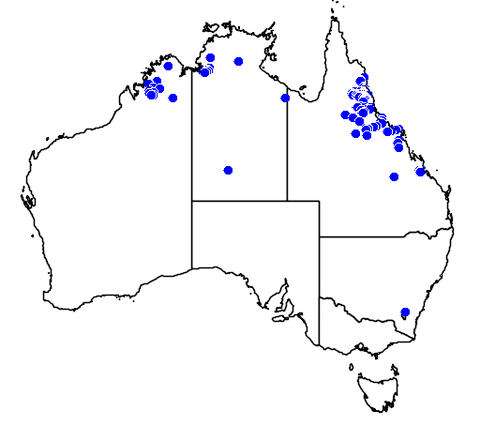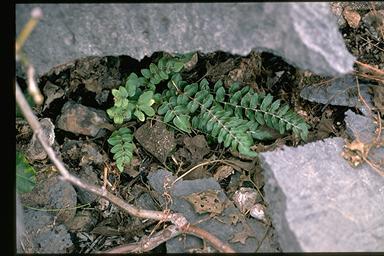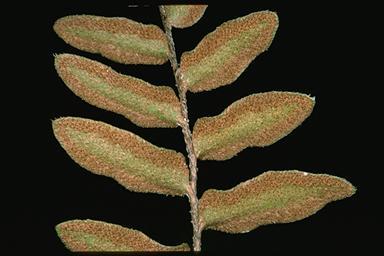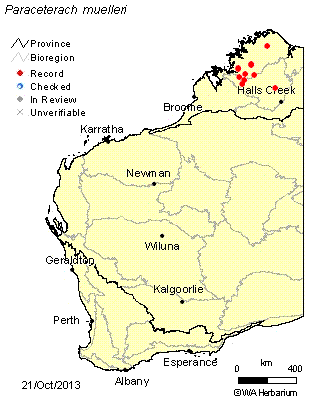Paraceterach mulleri is native to Western Australia and can be found at the very northern end of the state.
It is commonly found in granite crevices (Spooner, 1997).
This image was taken from Australian National Botanic Gardens. (http://www.anbg.gov.au/photo/apii/id/a/22805).
Photographer: Fagg, M.
Taken at : near Chillagoe QLD
Australian Plant Image Index (APII)- Photo No. : a.22805
Paraceterach mulleri is Not threatened in Western Australia (http://florabase.dpaw.wa.gov.au/browse/profile/13892 ), however in the Northern Territory it is considered nearly threatened (Department of land resource management, 2012).
This image was taken from Australian National Botanic Gardens (http://www.anbg.gov.au/photo/apii/id/a/22806).
Photographer: Fagg, M.
Taken at : near Chillagoe QLD
Australian Plant Image Index (APII)- Photo No. : a.22806
This Herbarium of Paraceterach mulleri shows the contrast of the upper and lower leaf and clarifies the detailed description bellow.
The image was taken from Tropicos.org. Missouri Botanical Garden.
The Rhizome grows along the ground for a little and the rest of the plant is almost standing upright. The Rhizome Scales are narrowly triangular with a length of 1.5mm, they have a thick black central band and pale thin, pliable borders.
The fronds (leaves) can range between 8 and 40cm in length.
The Stipes is brown to blackish brown and are closely packed in together. The stipes appears to be covered in triangular scales and a serrated edge with small hairs arranged in a series of single rows.
The blade of the leaves (the lamina) is densely covered in toothed scales and has a single coloured glossy appearance. When the Lamina is young it is undivided but as it ages the lamina becomes 1-pinate (it divides twice, into leaflets). The Indumentum is denser on the lower surface of the Lamina and the Rachises are very similar to the stipes. The leaves have free veins that are repeatedly forked.
The sori are concealed by the indumentums and are very narrow in relation to its length, with the sides mostly parallel to the veins and crowded around the margins.
The terminal pinna are fused with the first side shoot that grows form a shoot which develops from the main branches of the plant, to form a 3-lobed primary leaflets of a divided leaf/frond.
The lateral pinnae are ovate to round at a length of 1-3cm. The margins are undivided and without teeth. The Apices are blunt/rounded at the extremity. The surfaces bear ovate to narrowly ovate scales which are often abruptly broadened at the middle and the surfaces are narrowly attached heart shaped base. The scales on the lateral pinnae are pale brown and dense on the lower surface with long marginally fringed hairs. Scales on the upper surface are sparse and white.
The sorus is a discontinuous marginal band that is 3mm wide.
This description has been derived and simplified the official description on flora of Australia online, to read the technical description please click here.
Paraceteraach muelleri is not a very known and there very little credible literature available.
The classification tree is presented bellow and is recognized by the NCBI taxonomy.
Cellular organisms
Eukaryota
Viridiplantae
Streptophyta
Streptophytina
Embryophyta
Tracheophyta
Euphyllophyta
Moniliformopses
Polypodiopsida
Core leptosporangiate ferns
Polypodiales
Pteridaceae
Paraceterach
Paraceterach muelleri
In the Genus Paraceterach there are two species from Western Australia, p.muelleri and p.reynoldsii (ABRS, 1998)
Paraceterach muelleri can be found in the Following WA locations:
- Derby West Kimberley
- Halls Creek
- Wyngha-East Kimberley
This image displays the disruption of Paraceterach muelleri in WA.
The image was sourced from florabase.
Paraceterach muelleri can also be found in the Northern Territory and Queensland as displayed in the following image (taken from Australian Plant Census)
Paraceterach muelleri grows in rock crevices, on granite rock ledges and often shelters in vine thickets (FloraBase, Spooner, 1997).
There is no available literature that describes any uses for Paraceterach muelleri.





Recent comments